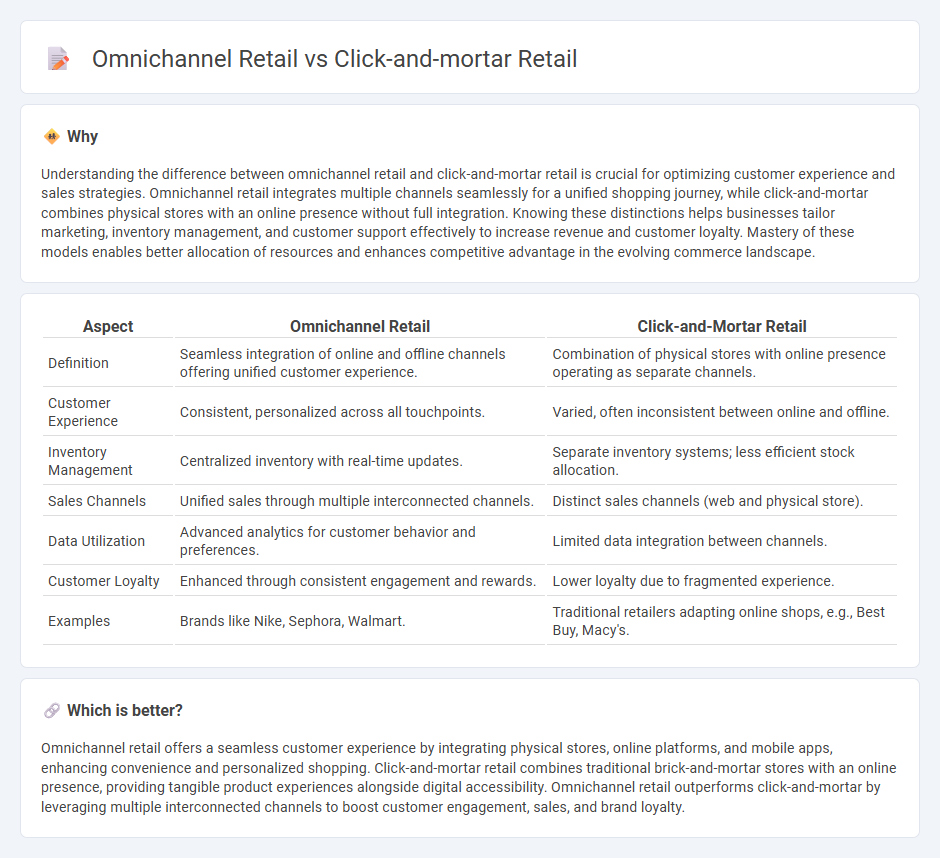
Omnichannel retail integrates multiple shopping channels, including physical stores, online platforms, mobile apps, and social media, to provide a seamless customer experience. Click-and-mortar retail combines traditional brick-and-mortar stores with an online presence, allowing customers to choose between in-store purchases and digital shopping. Explore the advantages and strategies of each model to optimize your retail business.
Why it is important
Understanding the difference between omnichannel retail and click-and-mortar retail is crucial for optimizing customer experience and sales strategies. Omnichannel retail integrates multiple channels seamlessly for a unified shopping journey, while click-and-mortar combines physical stores with an online presence without full integration. Knowing these distinctions helps businesses tailor marketing, inventory management, and customer support effectively to increase revenue and customer loyalty. Mastery of these models enables better allocation of resources and enhances competitive advantage in the evolving commerce landscape.
Comparison Table
| Aspect | Omnichannel Retail | Click-and-Mortar Retail |
|---|---|---|
| Definition | Seamless integration of online and offline channels offering unified customer experience. | Combination of physical stores with online presence operating as separate channels. |
| Customer Experience | Consistent, personalized across all touchpoints. | Varied, often inconsistent between online and offline. |
| Inventory Management | Centralized inventory with real-time updates. | Separate inventory systems; less efficient stock allocation. |
| Sales Channels | Unified sales through multiple interconnected channels. | Distinct sales channels (web and physical store). |
| Data Utilization | Advanced analytics for customer behavior and preferences. | Limited data integration between channels. |
| Customer Loyalty | Enhanced through consistent engagement and rewards. | Lower loyalty due to fragmented experience. |
| Examples | Brands like Nike, Sephora, Walmart. | Traditional retailers adapting online shops, e.g., Best Buy, Macy's. |
Which is better?
Omnichannel retail offers a seamless customer experience by integrating physical stores, online platforms, and mobile apps, enhancing convenience and personalized shopping. Click-and-mortar retail combines traditional brick-and-mortar stores with an online presence, providing tangible product experiences alongside digital accessibility. Omnichannel retail outperforms click-and-mortar by leveraging multiple interconnected channels to boost customer engagement, sales, and brand loyalty.
Connection
Omnichannel retail integrates multiple customer touchpoints, combining online and offline channels to deliver a seamless shopping experience, which is the foundational strategy behind click-and-mortar retail models. Click-and-mortar retailers leverage physical stores alongside e-commerce platforms to provide personalized services, real-time inventory access, and flexible fulfillment options like buy-online-pickup-in-store (BOPIS). This interconnected approach enhances customer engagement, improves operational efficiency, and drives higher sales conversion rates across digital and brick-and-mortar channels.
Key Terms
Online Integration
Click-and-mortar retail combines physical stores with online shopping options but often treats these channels as separate entities, leading to inconsistent customer experiences. Omnichannel retail seamlessly integrates online and offline channels using unified inventory management, personalized marketing, and synchronized customer data to deliver a consistent and convenient shopping journey. Explore how omnichannel strategies outperform click-and-mortar models in driving customer engagement and sales growth.
Brick-and-Mortar Presence
Click-and-mortar retail combines physical storefronts with an online presence, offering customers the convenience of in-store shopping alongside e-commerce options. Omnichannel retail integrates multiple channels, including brick-and-mortar stores, online platforms, mobile apps, and social media, to deliver a seamless and unified shopping experience across all touchpoints. Discover how strengthening brick-and-mortar presence enhances omnichannel strategies for maximum customer engagement.
Unified Customer Experience
Click-and-mortar retail combines physical stores with an online presence, offering customers separate experiences across channels, often leading to fragmented interactions. Omnichannel retail integrates all touchpoints into a unified customer experience, ensuring seamless engagement whether shoppers are online, in-store, or using mobile devices. Discover how omnichannel strategies enhance customer loyalty and drive sales by bridging physical and digital retail environments.
Source and External Links
What Is Click and Mortar? How Do They Work? - This article explains how click-and-mortar retail integrates online and offline sales channels to enhance the shopping experience.
Click and Mortar: Definition, Advantages & Disadvantages - This webpage provides a comprehensive overview of the click-and-mortar retail strategy, including its advantages and disadvantages.
What is a Click and Mortar Business Model? Examples, ... - This blog post discusses the click-and-mortar business model, its features, and examples of how it provides flexibility to customers in shopping online and offline.
 dowidth.com
dowidth.com